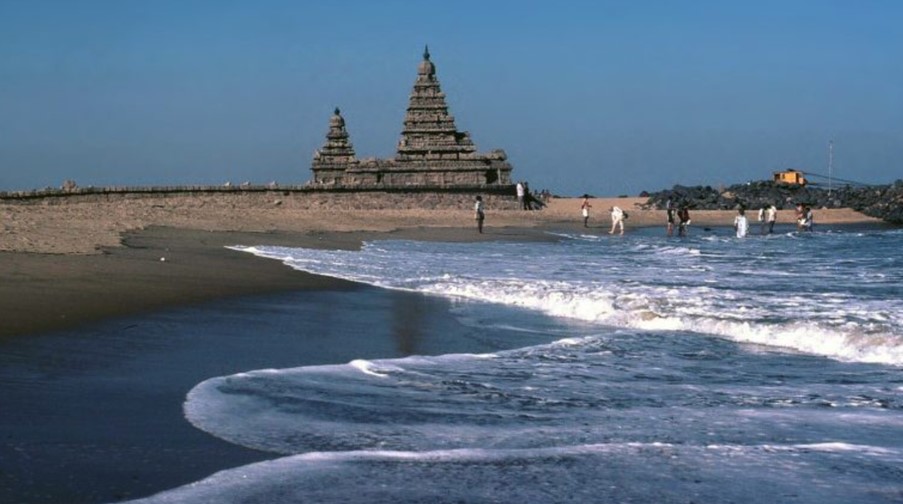Shore Temple, Tamil Nadu
A Hindu temple known as The Shore Temple is in Tamil Nadu, India’s seaside town of Mahabalipuram. One of the oldest still-standing temples from that period. It is one of the finest examples of early Dravidian construction.
The deity Shiva is honored at the temple. The exact details of the temple’s construction are still under research; people believe that the temple the Narasimhavarman II of the Pallavas built the temple in the eighth century AD.
The temple is renowned for its beautiful carvings and sculptures and is a UNESCO World Heritage Site. It is a part of the Mahabalipuram Group of Monuments, a UNESCO World Heritage Site.

The Shore Temple’s History
Between the fourth and ninth centuries AD, the Pallava dynasty reigned over southern India. Rajasimha is another name for Narasimhavarman II of the Pallavas, who built this temple.
The temple is known as the Shore Temple because he constructed it beside the shore. Given that it resists severe coastal weather, it is a distinctive architectural style for a temple. Granite is used in building the temple because it is strong and lasts a long time. It can also stand up to the effects of seawater and ocean erosion. Three shrines in the temple honor the Hindu gods Shiva, Vishnu, and Brahma in the main temple. Aside from images from Hindu mythology, the temple also has stunning statues of the Hindu pantheon’s gods and goddesses.
Numerous repairs and conservation efforts are to preserve the temple’s beauty and structural integrity. Due to the Bay of Bengal’s impact on coastal erosion, the temple’s original site was roughly 50 meters from where it is now. In the latter part of the 19th century, the temple relocated to its present site. The Archaeological Survey of India has taken over the protection of the temple complex, which is now accessible to tourists.
Architecture
The main temple is a five-story building with a 40-foot-tall pyramidal tower. The Shore Temple is renowned for its architectural details, such as the “Mandapam,” which is the hall for communal prayer, and the “Vimana,” which is the tower above the sanctum sanctorum. The primary deity’s idol would have been stored in the “Palliyarai,” a little chamber that is another component of the temple complex. Three shrines honor the Hindu god’s Shiva, Vishnu, and Brahma in the main temple.
The outside walls of the temple have delicate carvings of gods, animals, and other characters. People think that the sculptures in the temple are some of the best Pallava art and design. South of the first temple lies the second, smaller temple. It is dedicated to Lord Vishnu and is known for its exquisite sculptures of the deity in various forms.
Additionally, the temple features some little shrines and mandapas. The Shore Temple also uses monolithic rock-cut architecture, which entails carving a single, sizable piece of rock into a building or other structure. The architecture of ancient India often used this method. It may be in the gopurams and mandapas of the Shore Temple, out of granite rock.
Additionally, the Shore Temple has a distinctive fusion of architectural types. It represents a synthesis of the Pallava and Chola architectural styles, two mighty empires that controlled southern India at various times. The temple’s pyramidal tower displays Pallava architecture, while its elaborate carvings and sculptures depict Chola architecture.
When is the best time to visit the Shore Temple?
The temple is accessible to the public at all times and is open throughout the year. Nevertheless, winter is ideal since visiting and admiring the temple is more pleasant. Due to its tropical environment, Mahabalipuram has hot, humid summers and moderate winters.
The winter months of November through February are the ideal time to travel. The typical temperature during this period is between 25 and 30 degrees Celsius. If you want to escape the heat and comfortably take in the carvings and sculptures of the temple, winter is a perfect time.
